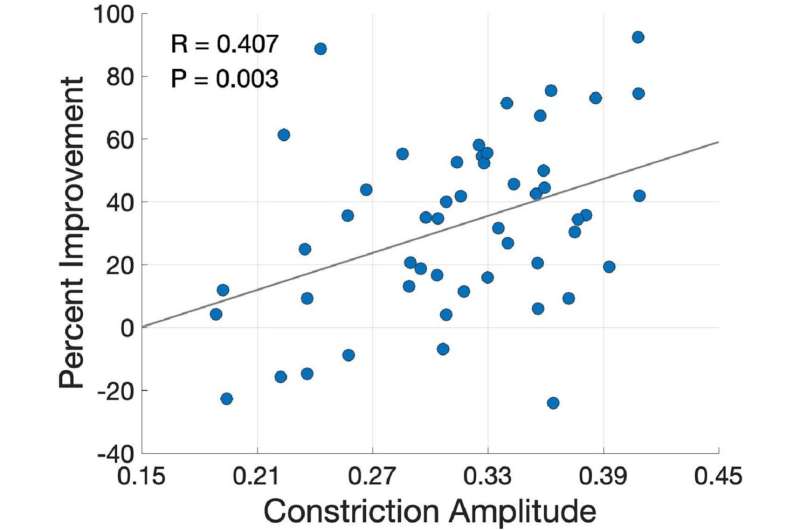This article has been reviewed according to Science X's editorial process and policies. Editors have highlighted the following attributes while ensuring the content's credibility:
fact-checked
peer-reviewed publication
trusted source
proofread
Pupil response may shed light on who responds best to transcranial magnetic stimulation for depression

New findings from researchers at UCLA Health suggest that measuring changes in how pupils react to light could help predict recovery from depression and personalize transcranial magnetic stimulation (TMS) treatment of major depressive disorder.
TMS is a safe, non-invasive therapy that uses magnetic fields to stimulate parts of the brain involved in mood regulation. While TMS is proven effective, not all patients respond equally well to the therapy. The ability to predict who will benefit most could allow doctors to better customize and target treatments.
In two recent studies, UCLA scientists found that the pupil's response to light before treatment correlated with improvements in depression symptoms over the course of therapy. Pupil size reflects activation of the autonomic nervous system, which controls involuntary functions and is negatively impacted in people with depression.
The first study, appearing in the Journal of Affective Disorders, reports on outcomes for 51 patients who underwent daily TMS sessions. Before receiving treatment, researchers measured the patients' baseline pupillary constriction amplitude, or CA: how much the pupil shrinks when exposed to light. The pupil's constriction is an indicator of parasympathetic nervous system function.
The researchers found a significant association between baseline pupil constriction amplitude and symptom improvement, indicating that a greater constriction amplitude at baseline was associated with a better outcome. In other words, those with larger pupil constriction in response to light at baseline showed greater symptom improvement over their full treatment.
The second study, appearing in Brain Stimulation, went further and compared patients who were treated for depression with one of two common TMS protocols: 10 Hz stimulation and intermittent theta burst stimulation (iTBS). In 10 Hz stimulation, magnetic pulses are delivered at a fixed rate of 10 pulses per second, or 10 Hz, a continuous and relatively high-frequency stimulation.
iTBS is a faster form of stimulation with bursts of three pulses at 50 Hz, repeated with short breaks between bursts. This pattern is thought to mimic the natural rhythm of certain brain activities.
The researchers found that people with slower pupillary constriction had significantly greater improvement in depression after 10 sessions if they received iTBS rather than 10 Hz treatment.
"These results suggest we may be able to use a simple test of the pupil to identify who is most likely to respond to electromagnetic stimulation of the brain to treat their depression," said researcher Cole Citrenbaum, lead author of both studies and a researcher with the TMS Clinical and Research Program at the Semel Institute for Neuroscience and Human Behavior at UCLA.
The researchers propose that measuring pupillary reactivity before starting TMS could eventually help guide treatment selection on an individual basis. "Additionally, we may be able to tailor the frequency of stimulation to the individual patient to maximize their benefit from treatment," Citrenbaum said. This personalized approach could lead to better outcomes for patients.
"At the present time, about 65% of patients treated with TMS have a substantial improvement in their depression," said Dr. Andrew F. Leuchter, senior author of both studies and Distinguished Professor of Psychiatry at the Jane and Jerry Semel Institute for Neuroscience and Human Behavior at UCLA.
"Our goal is to have more than 85% of patients fully recover from depression. As we better understand the complex brain activity underlying depression, we move closer to matching patients with the treatments that ensure their full recovery. Pupil testing may be one useful tool in reaching this goal."
The studies add to growing evidence on the benefits of biologically-based personalization in treating major depression. UCLA researchers plan further trials to confirm the value of pupillometry in optimizing transcranial magnetic stimulation.
More information: Cole Citrenbaum et al, Pretreatment pupillary reactivity is associated with outcome of Repetitive Transcranial Magnetic Stimulation (rTMS) treatment of Major Depressive Disorder (MDD), Journal of Affective Disorders (2023). DOI: 10.1016/j.jad.2023.07.008
Cole Citrenbaum et al, Pretreatment pupillary reactivity is associated with differential early response to 10 Hz and intermittent theta-burst repetitive transcranial magnetic stimulation (rTMS) treatment of major depressive disorder (MDD), Brain Stimulation (2023). DOI: 10.1016/j.brs.2023.10.006



















